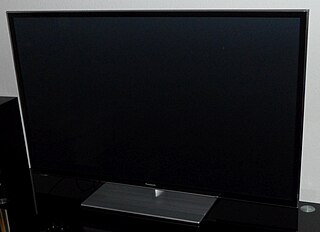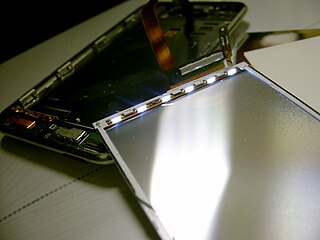
A liquid-crystal display (LCD) is a flat-panel display or other electronically modulated optical device that uses the light-modulating properties of liquid crystals combined with polarizers. Liquid crystals do not emit light directly but instead use a backlight or reflector to produce images in color or monochrome. LCDs are available to display arbitrary images or fixed images with low information content, which can be displayed or hidden: preset words, digits, and seven-segment displays are all examples of devices with these displays. They use the same basic technology, except that arbitrary images are made from a matrix of small pixels, while other displays have larger elements. LCDs can either be normally on (positive) or off (negative), depending on the polarizer arrangement. For example, a character positive LCD with a backlight will have black lettering on a background that is the color of the backlight, and a character negative LCD will have a black background with the letters being of the same color as the backlight.

Electroluminescence (EL) is an optical and electrical phenomenon, in which a material emits light in response to the passage of an electric current or to a strong electric field. This is distinct from black body light emission resulting from heat (incandescence), chemical reactions (chemiluminescence), reactions in a liquid (electrochemiluminescence), sound (sonoluminescence), or other mechanical action (mechanoluminescence).

Holography is a technique that enables a wavefront to be recorded and later reconstructed. It is best known as a method of generating three-dimensional images, and has a wide range of other uses, including data storage, microscopy, and interferometry. In principle, it is possible to make a hologram for any type of wave.

Poly(methyl methacrylate) (PMMA) is the synthetic polymer derived from methyl methacrylate. It is used as an engineering plastic, and it is a transparent thermoplastic. PMMA is also known as acrylic, acrylic glass, as well as by the trade names and brands Crylux, Hesalite, Plexiglas, Acrylite, Lucite, and Perspex, among several others. This plastic is often used in sheet form as a lightweight or shatter-resistant alternative to glass. It can also be used as a casting resin, in inks and coatings, and for many other purposes.

A plasma display panel (PDP) is a type of flat panel display that uses small cells containing plasma: ionized gas that responds to electric fields. Plasma televisions were the first large flat panel displays to be released to the public.

A backlight is a form of illumination used in liquid-crystal displays (LCDs) that illuminates an LCD from the side or back of a display panel. LCDs do not produce light by themselves, so they need illumination to produce a visible image. Backlights are often used in smartphones, computer displays, and LCD televisions. They are also used in small displays to increase readability in low light conditions such as in wristwatches. Typical sources of light for backlights include light-emitting diodes (LEDs) and cold cathode fluorescent lamps (CCFLs).

LIGA is a fabrication technology used to create high-aspect-ratio microstructures. The term is a German acronym for Lithographie, Galvanoformung, Abformung – lithography, electroplating, and molding.
X-ray optics is the branch of optics that manipulates X-rays instead of visible light. It deals with focusing and other ways of manipulating the X-ray beams for research techniques such as X-ray crystallography, X-ray fluorescence, small-angle X-ray scattering, X-ray microscopy, X-ray phase-contrast imaging, and X-ray astronomy.
Contrast in visual perception is a felt difference in appearance of two or more parts of a field seen simultaneously or successively.

Artificial nails, also known as fake nails, false nails, acrylic nails, nail extensions or nail enhancements, are extensions placed over fingernails as fashion accessories. Many artificial nail designs attempt to mimic the appearance of real fingernails as closely as possible, while others may deliberately stray in favor of an artistic look.

An LED-backlit LCD is a liquid-crystal display that uses LEDs for backlighting instead of traditional cold cathode fluorescent (CCFL) backlighting. LED-backlit displays use the same TFT LCD technologies as CCFL-backlit LCDs, but offer a variety of advantages over them.
A superluminescent diode is an edge-emitting semiconductor light source based on superluminescence. It combines the high power and brightness of laser diodes with the low coherence of conventional light-emitting diodes. Its emission optical bandwidth, also described as full-width at half maximum, can range from 5 up to 750 nm.
Time multiplexed optical shutter (TMOS) is a flat panel display technology developed, patented and commercialized by Uni-Pixel Displays, Inc. TMOS is based on the principles of total internal reflection (TIR), frustration of TIR (FTIR) and field sequential colour generation (FSC). This combination of features make it suitable for applications such as mobile phones, televisions and signalling systems.

A luminescent solar concentrator (LSC) is a device for concentrating radiation, solar radiation in particular, to produce electricity. Luminescent solar concentrators operate on the principle of collecting radiation over a large area, converting it by luminescence and directing the generated radiation into a relatively small output target.

Structural coloration in animals, and a few plants, is the production of colour by microscopically structured surfaces fine enough to interfere with visible light instead of pigments, although some structural coloration occurs in combination with pigments. For example, peacock tail feathers are pigmented brown, but their microscopic structure makes them also reflect blue, turquoise, and green light, and they are often iridescent.
Liquid optically-clear adhesive (LOCA) is liquid-based bonding technology used in touch panels and display devices to bind the cover lens, plastic, or other optical materials to the main sensor unit or each other. These adhesives improve optical characteristics and durability. LOCA glue is often hardened using ultraviolet light.
A see-through display or transparent display is an electronic display that allows the user to see what is shown on the screen while still being able to see through it. The main applications of this type of display are in head-up displays, augmented reality systems, digital signage, and general large-scale spatial light modulation. They should be distinguished from image-combination systems which achieve visually similar effects by optically combining multiple images in the field of view. Transparent displays embed the active matrix of the display in the field of view, which generally allows them to be more compact than combination-based systems.

Cast Acrylic is a form of poly(methyl methacrylate) (PMMA). It is formed by casting the monomer, methyl methacrylate, mixed with initiators and possibly other additives into a form or mold. Sheet and rod stock are generated by casting into static forms, while tubing is done in rotational molds.

Transparent wood composites are novel wood materials which have up to 90% transparency. Some have better mechanical properties than wood itself. They were made for the first time in 1992. These materials are significantly more biodegradable than glass and plastics. Transparent wood is also shatterproof, making it suitable for applications like cell phone screens.

A Notification LED is a small RGB or monochrome LED light usually present on the front-facing screen bezel of smartphones and feature phones whose purpose is to blink or pulse to notify the phone user of missed calls, incoming SMS messages, notifications from other apps, low battery warning, etc., and optionally to facilitate locating the mobile phone in darkness. It usually pulses in a continuous way to draw the attention of the user. It is a part of the device's notification system that uses a cloud-powered push notification service to relay remote notification messages to the user, or local notifications. Similar to audio notifications, a notification LED is a very battery-efficient way to inform the user of new notifications without turning on the screen at all.














